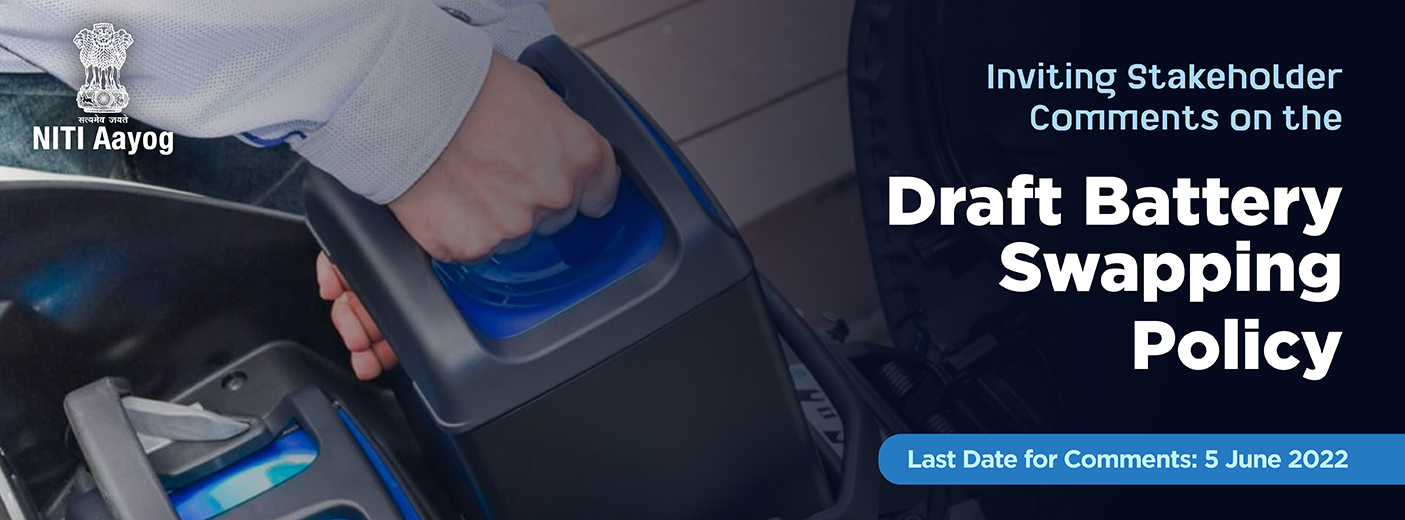Context
-
Government think-tank Niti Aayog has prepared a draft battery swapping policy, under which it has proposed offering incentives to electric vehicles (EVs) with swappable batteries, subsidies to companies manufacturing swappable batteries, a new battery-as-a-service business model, and standards for interoperable batteries, among other measures.
About Draft Battery Swapping Policy
- The policy is targeted at supporting the adoption of battery-swapping, primarily for battery swapping systems used in electric scooters and three-wheeler electric rickshaws.
- The draft policy has suggested that the GST Council consider reducing the differential across the tax rates on Lithium-ion batteries and electric vehicle supply equipment. Currently, the tax rate on the former is 18 per cent, and 5 per cent on the latter.

- The policy also proposes to offer the same incentives available to electric vehicles that come pre-equipped with a fixed battery to electric vehicles with swappable batteries. The size of the incentive could be determined based on the kWh (kilowatt hour) rating of the battery and compatible EV.
- An appropriate multiplier may be applied to the subsidy allocated to battery providers to account for the float battery requirements for battery swapping stations in different battery swapping ecosystems.
- The government will also specify a minimum contract duration for a contract to be signed between EV users and battery providers to ensure they continue to provide battery swapping services after receiving the subsidy.
- The policy also requires state governments to ensure public battery charging stations are eligible for EV power connections with concessional tariffs.
- It also proposes to bring such stations under existing or future time-of-day (ToD) tariff regimes, so that the swappable batteries can be charged during off-peak periods when electricity tariffs are low.
- Transport Departments and State Transport Authorities will be responsible for easing registration processes for vehicles sold without batteries or for vehicles with battery swapping functionality
- Municipal corporations will be responsible for planning, zoning permissions and land allocation for battery swapping stations.
- The policy also proposes to assign a unique identification number (UIN) to swappable batteries at the manufacturing stage to help track and monitor them.
- Similarly, a UIN number will be assigned to each battery swapping station.
- It also proposes to install battery swapping stations at several locations like retail fuel outlets, public parking areas, malls, kirana shops and general stores etc.
- The policy will only support batteries using Advanced Chemistry Cells (ACC), with performance that is equivalent or superior to EV batteries supported under the government’s FAME-II scheme.
What is battery swapping?
- Battery swapping is a mechanism that involves exchanging discharged batteries for charged ones.
- This provides the flexibility to charge these batteries separately by de-linking charging and battery usage, and keeps the vehicle in operational mode with negligible downtime.
- Battery swapping is generally used for smaller vehicles such as two-wheelers and three-wheelers with smaller batteries that are easier to swap, compared to four-wheelers and e-buses, although solutions are emerging for these larger segments as well.
What is the battery-as-a-service model?
- Niti Aayog said battery swapping will fall under the battery-as-a-service (BaaS) business model, and such models would have to ensure interoperability between EVs and batteries for a successful mainstreaming of battery swapping as an alternative.
- Given the nascency of battery swapping, interoperability between EV batteries and other components within a battery swapping ecosystem is adequate for eligibility under the policy, as long as all components within the ecosystem adhere to the technical and performance standards defined for BaaS and battery swapping services.
- Apart from the batteries themselves, major battery providers will be encouraged to sign data-sharing agreements to provide information on battery health and performance, and to enable more flexibility to consumers through peer-to-peer roaming networks.
Does the draft policy talk about EV safety?
- To ensure a high level of protection at the electrical interface, a rigorous testing protocol will be adopted, to avoid any unwanted temperature rise at the electrical interface. The battery management system, which is a software that controls battery functions, will have to be self-certified and open for testing to check its compatibility with various systems, and capability to meet safety requirements.
- Batteries shall be tested and certified as per AIS 156 (2020) and AIS 038 Rev 2 (2020) standards for safety of traction battery packs, as well as additional tests that may be prescribed for swappable batteries which are subject to multiple coupling/decoupling processes at the connectors.
- Additionally, for better protection of assets, swappable batteries will have to be equipped with advanced features like IoT-based battery monitoring systems, remote monitoring and immobilisation capabilities.
- The Aayog has proposed that all metropolitan cities with a population of more than 40 lakh will be prioritised for the development of battery swapping networks under the first phase, which is within 1-2 years of the draft policy getting finalised.
- Other major cities such as state capitals with a population greater than 5 lakh will be covered under the second phase.
Reference:
https://indianexpress.com/article/explained/india-battery-swapping-policy-draft-explained-7879898/
Visit Abhiyan PEDIA (One of the Most Followed / Recommended) for UPSC Revisions: Click Here
IAS Abhiyan is now on Telegram: Click on the Below link to Join our Channels to stay Updated
IAS Abhiyan Official: Click Here to Join
For UPSC Mains Value Edition (Facts, Quotes, Best Practices, Case Studies): Click Here to Join
